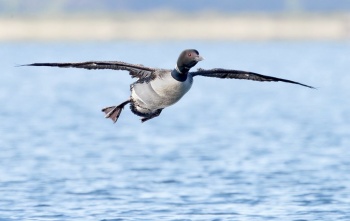Alternative name: Great Northern Diver; Great Northern Loon
- Gavia immer
Identification
Length 65-91cm (25½-35¾ in)
Wingspan 137cm
The most numerous loon in North America and a familiar bird on its breeding grounds.
Adult breeding
- Black above with bold white chequer-spots
- White below
- Head black with collar of short vertical white stripes, broadest on hindneck
- Half-necklace of white spots below chin
Adult non-breeding
- Blackish-grey above and white below
- Lacks sharp contrast seen in Black-throated Diver (G. arctica)
- Head and neck usually darker than back
- Shows indistinct half-collar at base of hindneck
- Usually lacks white flank patch.
Some show whitish bills but culmen is always dark.
Similar Species
Best distinguished from smaller species by heavy build and bill and from the Yellow-billed Diver (G. adamsii) by straighter, usually darker bill, held horizontally.
Distribution
Breeding
Common and widespread across North America breeding from Alaska south to northern Washington and east to the Great Lakes and New England. Absent from north-central Arctic Canada and south-central Canada. Also breeds in Greenland and Iceland. Possibly breeds regularly on Bear Island and has bred in Scotland.
Non-breeding
Winters in North America from the Aleutians south to northern Mexico in the west and from Newfoundland to the Gulf Coast in the east. European birds winter from Iceland and northern Norway south to northwest France with vagrants recorded on the Azores, on the Mediterranean coast of North Africa and in Ukraine.
Taxonomy
This is a monotypic species[1], but birds from western Canada are sometimes separated as race elasson.
Habitat
Breeds on medium-large, deep lakes in tundra and forest areas.
Winters at sea in bays and estuaries, sometimes large inland waters.
Behaviour
Breeding
Breeds late-May or early June to September. Nests beside water often on an island or spit, a shallow scrape or more rarely a substantial mound of vegetation built in shallow water in reedbeds. Eggs: 2 (1 in replacement clutch), olive-brown, sometimes more greenish with sparse black blotches (90 x 57mm). Incubated by both sexes for 29-30 days. Young tended by both sexes, feed themselves at 40 days and fly at about 72 days
Diet
Fish, also molluscs and crustaceans caught during 60-120 second dives.
Vocalisation
Familiar loud wailing and yodelling calls during the breeding season.
References
- Clements, J. F., T. S. Schulenberg, M. J. Iliff, S. M. Billerman, T. A. Fredericks, B. L. Sullivan, and C. L. Wood. 2019. The eBird/Clements Checklist of Birds of the World: v2019. Downloaded from http://www.birds.cornell.edu/clementschecklist/download/
Recommended Citation
- BirdForum Opus contributors. (2025) Common Loon. In: BirdForum, the forum for wild birds and birding. Retrieved 11 May 2025 from https://www.birdforum.net/opus/Common_Loon
External Links
GSearch checked for 2020 platform.1







